Few would ever have heard of Bulqiza were it not for the “sparkly black stone.” That is how locals in the north eastern Albanian town refer to chromite, which is found in abundance in the town’s large chromite mine — the biggest in the country. Their whole life is tied to the mine. In fact, the town itself was built around it.
“It’s hard to find someone in Bulqiza who hasn’t worked in the mine or who has no relative who has worked in the mine,” a local says.
The production of chromite in Bulqiza started during the Italian fascist invasion in 1942. Initially, they extracted what they could find on the surface. After a few years, at the beginning of 1948, the mine started to operate under the Albanian communist government. In the following decades, they expanded to searching for chromite vertically — underground.
The town’s mine has employed hundreds of miners at a time. The city’s first apartment buildings, which were two or three stories high, were built for them in the ’60s and ’70s. During that period, besides the miners, prisoners were also made to carry out forced labor in the mines, as was the practice of Enver Hoxha’s communist regime.
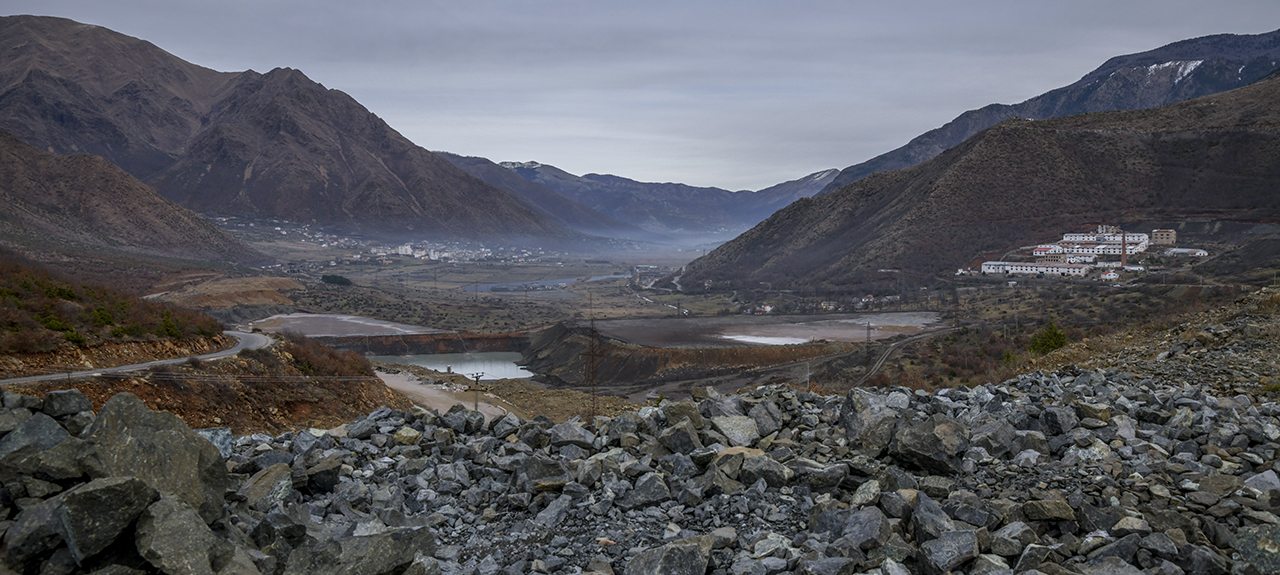
Bulqiza, which is home to the biggest chromite mine in Albania, has been crippled from poverty. Photo: Atdhe Mulla / K2.0.
Over many decades, Albania has exported millions of tonnes of sparkly black stones. Used extensively in global industry, especially the steel industry, chromite is one of the country’s most important mineral resources.
Today, the country’s mines are still operational. Thousands of tonnes of chromite are extracted to the surface from their depths each year. But unlike during Hoxha’s regime, most mines in Albania are now managed by private companies, because the Albanian state decided to set up concession agreements for them.
The chromite mine in Bulqiza was conceded to the private sector in 2001. It is divided into several sections, or galleries as they are known in miners’ discourse, which are managed by dozens of different companies. The greatest surface area is covered by AlbChrome, which employs over 600 miners.
This company, together with dozens of others, is part of the Balfin Group, one of the biggest private investment conglomerates in southeastern Europe and one that has businesses in various other fields, including real estate and commercial industrial spaces. Balfin Group is owned by the richest man in Albania, Samir Mane, a controversial figure who has been accused by civil society activists of violating the rights of miners.
Albanian media have reported from Bulqiza on the mafia, political influence, killings between businessmen, corruption and the violation of the labor rights of miners, as well as their work-related injuries and deaths.
Despite having rich underground assets, Bulqiza is still one of the poorest areas in Albania; according to the Labor Office in Bulqiza Municipality, 28% of residents were unemployed in 2016.
Women are most affected by unemployment. “Some might prejudge us because our women don’t work, but they have nowhere to work,” says a Bulqiza local when asked how many people in their family work.
Beyond the figures, even at first sight Bulqiza gives the impression that it is a poor town. Most buildings are old, the roads narrow and unpaved. Around the main square, many places are closed with signs indicating that they are “For Rent.”

The first apartments in Bulqiza were built for miners in the ’60s and ’70s. Photo: Atdhe Mulla / K2.0.
The town comes alive early in the morning, before the miners begin the first shift, and again just before midnight, when many of them end the third and final shift. For less than an hour in each of these periods, two cafés, Duriçi and Cupi, are full of miners — then they remain empty until the next shift.
Albanian media have reported from Bulqiza on the mafia, political influence, killings between businessmen, corruption and the violation of the labor rights of miners, as well as their work-related injuries and deaths.
Even before entering Bulqiza, the K2.0 team saw an ambulance coming down from the mine. Since news about accidents in mines are common, the team decided to follow the ambulance. Inside was Tushë Asllani, a miner who had injured his eye while working underground. He received medical treatment in the town hospital before being sent to Tirana.
According to a 2015 BIRN investigation, in the preceding decade accidents in Albania’s mines caused the deaths of around 300 miners. In recent years in Bulqiza alone, 22 miners — including seven AlbChrome employees — have died in the mine’s galleries.
In many cases that end in fatalities, state institutions have blamed the victims; the media in Albania have reported that miner-employing companies, some of which have had close political ties revealed, are rarely prosecuted by judicial authorities.
In November 2019, hundreds of Bulqiza miners got together and formed a new union — the Syndicate of Unified Miners of Bulqiza (SMBB) — to demand better working conditions. They say that just a few days after the union was established, AlbChrome started to dismiss unionists from work and apply pressure on miners due to their engagement in activism.
When AlbChrome started to undertake these measures, miners and civil society members in Albania organized protests against the owner of the company, Samir Mane, accusing him of trying to eliminate their union through the unjust dismissal of their members. The activists also organized a campaign under the slogan “Boycott Samir Mane,” calling on citizens to boycott his businesses, which are prevalent throughout the country.
Bulqiza unionists started to strike one day before the November 26 earthquake that rocked Albania, but put it on hold for a few days as a sign of solidarity with the dozens of victims who lost their lives in the natural disaster. However, they say that some of their colleagues — who weren’t part of the strike — had to work in the hours after the earthquake struck. This incited their revolt further, and they continue to seek better working conditions to this day.
Many family members of deceased miners refuse to speak openly. They sit and talk about the accidents and the final moments of their loved ones’ lives, they blame private companies and state authorities — but they do not allow the publication of their names. Some work in the mines themselves, others in public institutions, and they are afraid that they may lose their jobs. Others are afraid that they may lose the financial compensation that they are eligible to receive as a result of losing their loved ones.
From the many stories heard during K2.0’s stay in Bulqiza, we bring those of four miners and their families.
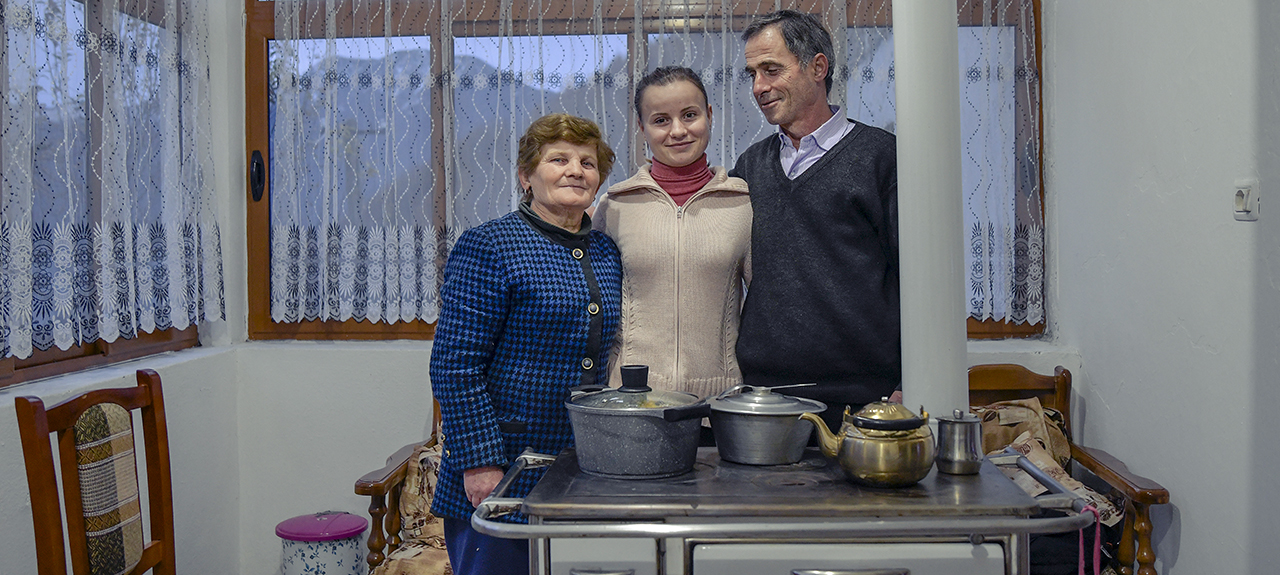
Miner Lahim Boja, who has been working in the chromite mine for over 35 years, lives with his family in Fushë Bulqiza. Photo: Atdhe Mulla / K2.0.
No finger, no compensation
For many years now, Lahim Boja has started his day before 5 a.m. He quickly eats breakfast and leaves his house. After walking for a few minutes along a steep, unpaved road, the 53-year-old stops and waits for the bus that takes him from Fushë Bulqiza to the center of Bulqiza.
He arrives there a few minutes past 6 a.m. and goes straight to Cupi café, where he has his morning coffee together with his colleagues from the mines. Within half an hour, after Lahim and his colleagues have left for work, the café is completely empty.
One by one, the miners walk up the hill to the entrance of the mine — the “row of ants,” as the locals have termed it. From 6:45 a.m., the miners start to enter the mines managed by AlbChrome, and continue to work until 3 p.m.
This is more or less how October 10, 2016 started for Lahim, who has been working in Bulqiza’s chromite mine for more than 35 years; his role is to secure the cages used by the hundreds of miners as they descend deep into the mines. But that day would not turn out to be a normal one for the miner.
On that day, around 7:30 a.m., Lahim and three of his colleagues descended 14 stories deep with the cage. Equipped with a spanner, a hammer, a chisel, welding tools, a mask and a helmet, and secured with a rope, he was carrying out checks above the cage, while his colleagues were inside.
As he was checking one of the shaft’s supporting pillars, it detached, catching his thumb. “The finger fell off, and I went back down inside the cage, still tied to the ropes,” he recalls.
When the other miners saw the blood, they quickly ripped a T-shirt and tied it around the wound. Afterwards, the mine’s ambulance took him to the local hospital in Bulqiza. The doctors couldn’t do anything about his thumb, they could only ease his pain. Lahim was treated at the hospital for 10 days.
The veteran miner returned to work three months after suffering the injury and continues to work for the same company today.
In the weeks following the injury, as he started his recovery on medical leave, he wanted to have a word with his employers as he feared that they would change his job position and lower his monthly salary of 54,000 lekë (around 445 euros).
Relieved to discover this wasn’t going to happen, he turned his attention to the financial compensation that he is entitled to as a result of losing a finger in the workplace.
“I pay insurance — that’s my money,” Lahim insists. “Why shouldn’t they give it to me?”
According to Lahim, the company told him that the gallery poses risks and that there is a chance of injury but that he is entitled to compensation.
“So give it to me!” he recalls telling them, to placating reassurances: “‘We will, we will.’”
“I wait, and wait, and wait — three years have passed since,” he says, full of rancor.
Lahim says that there was no police report about his accident and insists that this is penalizing him, preventing him from receiving financial compensation. “I believed them, but they didn’t do it,” he says.
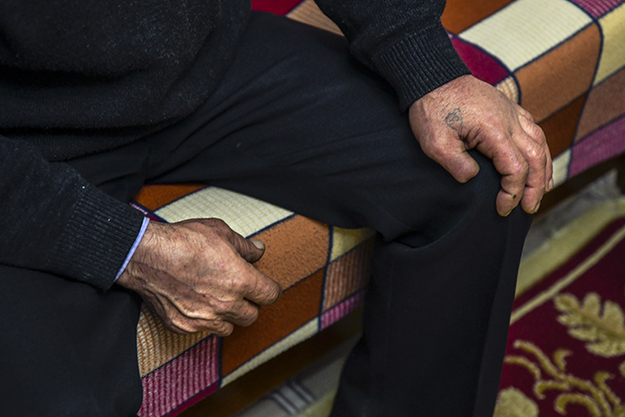
On the morning of October 6, 2016, Lahim lost his thumb in a work accident in the Bulqiza mine. Photo: Atdhe Mulla / K2.0.
The veteran miner returned to work three months after suffering the injury and continues to work for the same company today. He says that ever since he returned to work, his colleagues have been more careful around him and often spare him from heavy duty work. But he adds that, to date, this is the only care that he has received in the workplace since he lost his thumb.
Although he has continued making efforts to access financial compensation — he claims that four or five months ago he went to the central offices of AlbChrom in Tirana — he still doesn’t know when he will receive it.
Lahim’s says his family is not in a good financial situation so he’s in dire need of the money. His wife and daughters have never managed to get a job, while his son migrated to Greece after also being unable to find work.
In these circumstances, Lahim cannot afford to rest in the afternoon after finishing his work in the mine. Together with his wife and daughters, he works the garden and cares for the cattle. On days when he doesn’t have to work in the mines, he does this work full time.
The benefits of such domestic work are that the family does not need to buy onions, beans, eggs, milk, cheese and yogurt, poultry, or some fruits. This is how they save money.
“We don’t buy raki either,” Lahim says with a smile as he raises his glass full of raki that he made with his wife. “For better or for worse, we are getting by.”
Regarding his demand for compensation, he is adamant that he won’t give up. “Even if it’s just 5 lekë,” he says. “It’s my money.”
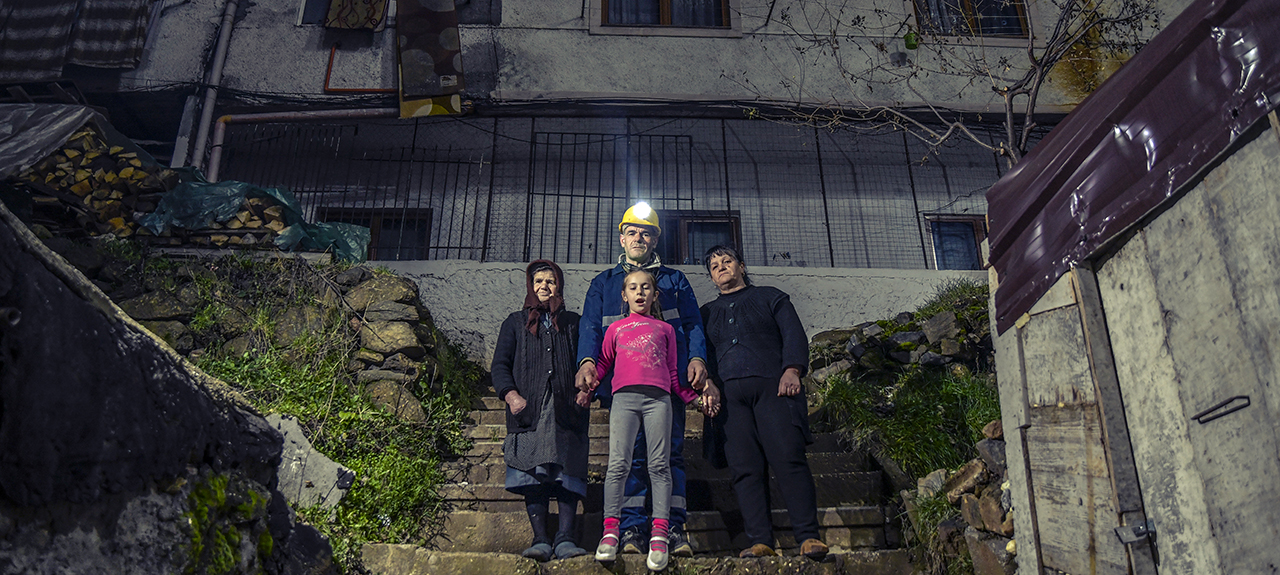
Ferhat Kurti’s family has been living in Bulqiza ever since he started working in the mine three decades ago. Photo: Atdhe Mulla / K2.0.
Face to face with a bear on the way to work
A few meters from the center of Old Bulqiza, Ferhat Kurti lives in a three-room apartment with his wife, mother and two children. His family moved to Bulqiza around 30 years ago when Ferhat, now 54, started to work as a miner.
The town center is as far from his house as the mines in which he worked for the past 30 years. Ferhat has lived just about his whole life in this area. His two sons grew up there, but then they migrated. Nevertheless, the area also brings back bad memories for him.
More than 10 years ago, as he was working five stories deep in the Bulqiza mine, he experienced severe pain in his chest. He stopped for a bit, but after a few minutes he continued his work, even though he wasn’t quite feeling himself. He decided to end his shift that day, but he still felt pain later when he went home.
Despite the uncomfortable feeling, the next day he woke up and went to work as usual. He reluctantly mentioned how he was feeling to his colleagues. They responded immediately, insisting that he go to see a doctor after finishing his shift.
“Oh, oh, oh,” he recalls the doctor crying.
Ferhat had suffered a heart attack; he was hospitalized, somewhat against his will.
“I didn’t feel much pain,” he says, adding that he felt useless. “I was very angry, very angry.”
He believed that he was strong enough to continue working. And he also knew that his family needed him to work, because his salary was his family’s only source of income.
After one week, with mixed emotions, he decided to leave the hospital. He immediately went back to work, without making a big deal out of the heart attack. For two weeks, he continued to dig in the mine, until one day he suffered a second heart attack. This time, he was left unconscious.
“I just remember waking up in the hospital,” he recalls.
On this occasion, he had no choice but to rest for longer. His leave was extended after he suffered a third heart attack two months after the second. “We are not that educated, but I believe that the dust [in the mines] caused it,” Ferhat says.
Even after suffering three heart attacks, he continued to work in the mines for almost another decade.
Even before his heart attacks, his decades of work in the mines had left clear marks on his body. Looking at his hands from up close, it’s noticeable that his fingertips have been worn away from years of digging.
Despite the toll the job has taken on his health, he believes that he’s still physically able to continue working in the mines. To justify his insistence, he mentions the many accidents that he’s survived in the Bulqiza mine over the years, including cases in which his colleagues have died as a result of rock falls or gas explosions, and he points to the many work-related wounds that he has all over his body.
Even after suffering three heart attacks, he continued to work in the mines for almost another decade — not as a miner, but as a ventilation support worker, ensuring that there is oxygen deep in the mines.
Not only did he manage to keep his job, he also took part in strikes and protests. One of the biggest was the 2011 strike, in which miners demands included a wage increase and investments in the mine. However, he says he didn’t really benefit from it.
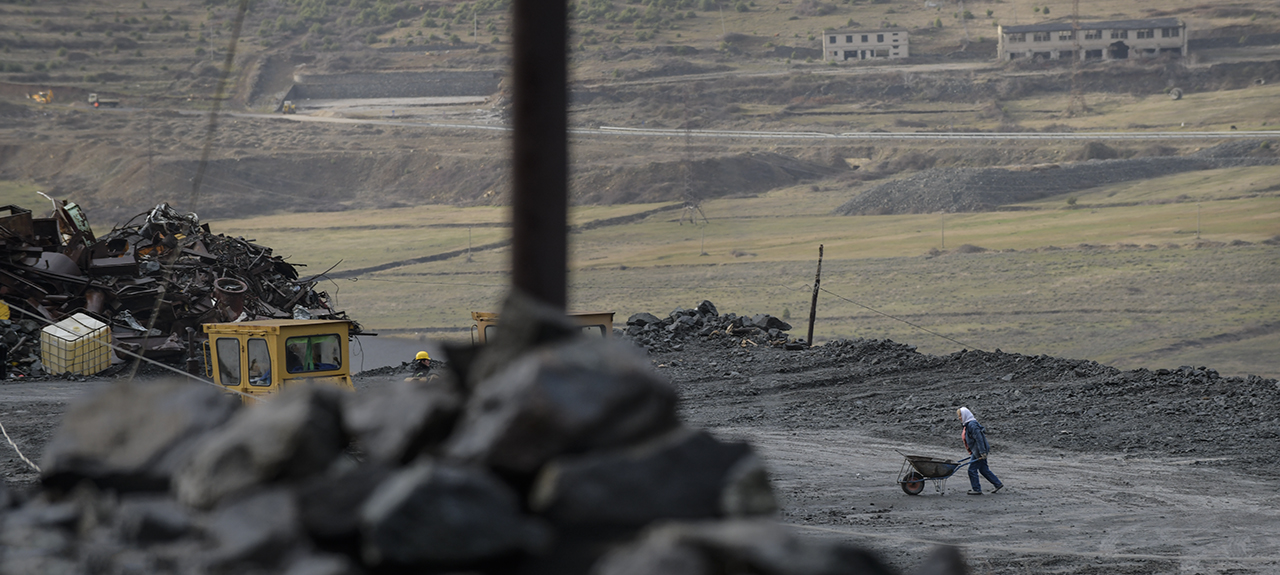
The Albanian media has reported that many women have lost their lives while working in the country’s mines, usually while extracting chromite from opencast coalfields above ground. Photo: Atdhe Mulla / K2.0.
In 2013, as a result of a concession, AlbChrome became responsible for managing the gallery in which he works.
After a while, he was to face more trouble, this time as a result of the annual Labor Day protest. “To be in Bulqiza and to not go out [to protest] on May 1st?” asks Ferhat rhetorically, recalling the day in 2017 when miners held a symbolic protest in front of the mines.
On that day, his anger was mostly directed at the leaders of the miners’ union, which he says didn’t pressure the company enough to increase wages or improve working conditions.
“I went a bit overboard — I told him [the head of the union] that they are psychological and economic murderers of miners,” recalls Ferhat, admitting that it was excessive, but insisting that it was no worse than that.
He says that a few days later he was called to the company offices to explain his reaction and that he was subsequently notified that he had been suspended from work for three months. During that time, he received his monthly salary as he awaited a decision on his future.
The company officials ultimately decided to transfer him to Burrel, around 7 kilometers from Bulqiza, to work in the chromite processing plant. They told him that the decision had been taken due to his cardiovascular issues. “You’re the ones with a bad heart,” Ferhat recalls saying to them in response.
He believes that the decision to relocate him came as a result of his participation in the protest, not because they cared about his health. “I took it as being exiled, because I had raised my voice,” he says.
Despite his reservations, the miner agreed to work in Burrel. But unlike before, he now had to walk for many kilometers on a mountainous road. “I came face to face with a bear on my way to work,” Ferhat says.
He says that he notified his supervisors about the case, but no one addressed the issue.
Ferhat worked there until the summer of 2019. Then, in June, he was dismissed. He says the justification he received was that he had violated work ethics by swearing and physically abusing his supervisors during a confrontation that happened after he requested to return to work in Bulqiza.
He has subsequently been unemployed for the past six months. To alleviate the economic condition of his family, his wife started to work illegally at a private opencast coalfield, where chromite is extracted above ground.
In the past, one of their sons, who now lives in Germany, also worked illegally in a mine for less than a year, until a foot injury forced him to leave his job.
He recalls his son’s words to him about the industry in which he had made his profession:
“‘You worked for 30 years and what did you achieve? When you couldn’t achieve anything for all those years, what will I achieve?’”
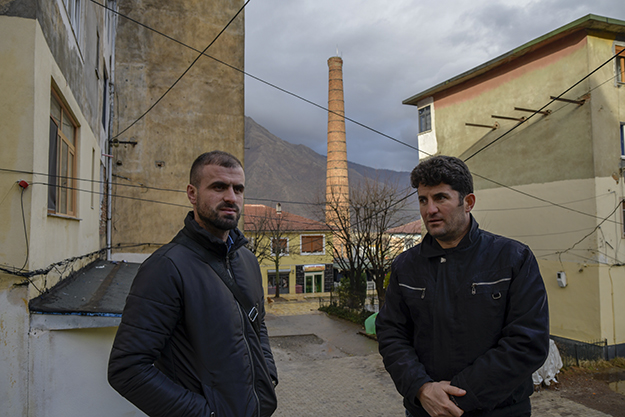
Elton Debreshi and Beqir Duriçi, who have been working for AlbChrome for many years, are two of the co-founders of the new miners’ union. Photo: Atdhe Mulla / K2.0.
The third generation revolt
Before he reached the age of 20, Elton Debreshi decided to leave Bulqiza.
Facing difficulties in finding work in his hometown, he felt forced to migrate to Greece, where he worked different jobs, mainly in the construction sector. But it was the time when the Greek state was engulfed by the economic crisis, which ultimately left hundreds of thousands of youths, including him, unemployed.
In 2010, Elton returned to Bulqiza, but was considering going back to Greece again. His plans changed when he was involved in a motorcycle accident that disabled him from working in the months that followed.
When he recovered, he started to look for a job in the town. And as all locals know, the mine comprises one of the few employment opportunities.
He knew how to work the mine because his father had worked in Bulqiza’s mine for more than 30 years, and his grandfather had worked there ever since it first opened. So in April 2010, he continued the family tradition.
That year was the third year in the industry for another local youth, Beqir Duriqi, who was also continuing the tradition of the men in his family.
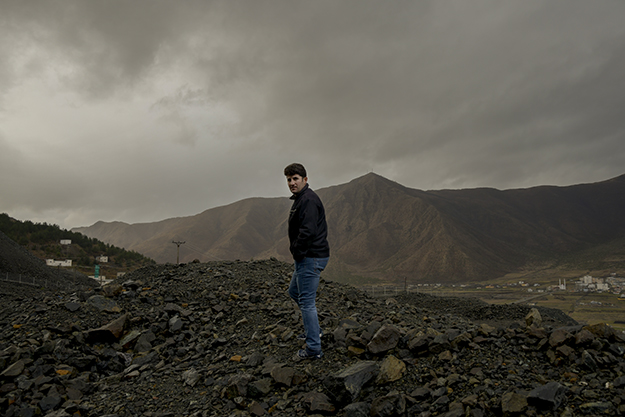
Beqir Duriçi has been in the mining industry for many years, just like his brother, father and grandfather before him. Photo: Atdhe Mulla / K2.0.
Beqir remembers the first few years as being particularly difficult, with many accidents, harsh working conditions and low wages.
He recalls a time when the miners boycotted work for a few months, forcing their employers to increase their wages. He was also part of the 2011 strike, two years after which his employer changed. The part of the mine in which he was working moved under the management of AlbChrome, which had promised that it would invest in the mine.
Elton heard the rumors that the new managing company responsible for these galleries would provide better working conditions and he was convinced to switch employers. In February 2014 he made the move, and until the end of 2019, Elton and Beqir worked for the same company. But both say that AlbChrome’s promises to improve conditions for the miners have not been fulfilled.
“The truth is that the company only invested in digging deeper in the mines, and they did this for their own profit,” Beqir says.
According to Beqir, this only increased the volume of work, but the company didn’t increase their wages, nor did it improve their working conditions.
Looking back at his last few years in the job, Elton recalls many injuries. “The Tirana-Bulqiza helicopter line became like a minibus line,” he says.
There were also a number of fatalities.
For Elton, the one that stands out most in his memory is the case of 27-year-old Eduard Damas. On a fateful day in 2017, news of a fatality spread quickly in Bulqiza. But Damas’ name was not immediately released, only his initials — they happened to be the same as Elton’s.
Elton received a flurry of calls from his friends and relatives, but he had no network on his phone. He had also heard about the fatal accident, and was trying to find out whether his father and younger brother, who were also working in the mine, had suffered injuries. Only after they finished work did the Debreshi family find out about one another’s fate.
Elton and Beqir were tired of the whole situation. They were particularly angry at the miners’ union, who they believed wasn’t doing its job and was siding with the company, not the miners. As such, they demanded a response from the union, and they particularly demanded a wage increase. The union heads said that they would talk to the company.
Less than a week later, the union heads notified Beqir that the company would not increase wages. Beqir, Elton and about 30 other miners who had prepared the demand, were especially angered by this.
The group started to collect signatures to form a new union. The directors of the company and heads of the union found out. Within a few days, a decision was made to change Elton and Beqir’s job positions.
“They took me 17 levels deep, where the work is harder,” Beqir says.
Meanwhile, Elton was transferred from being a miner to minecart driver. Both continued to work in their respective new positions, but they simultaneously continued to collect colleagues’ signatures, before submitting a court request to register their new union.
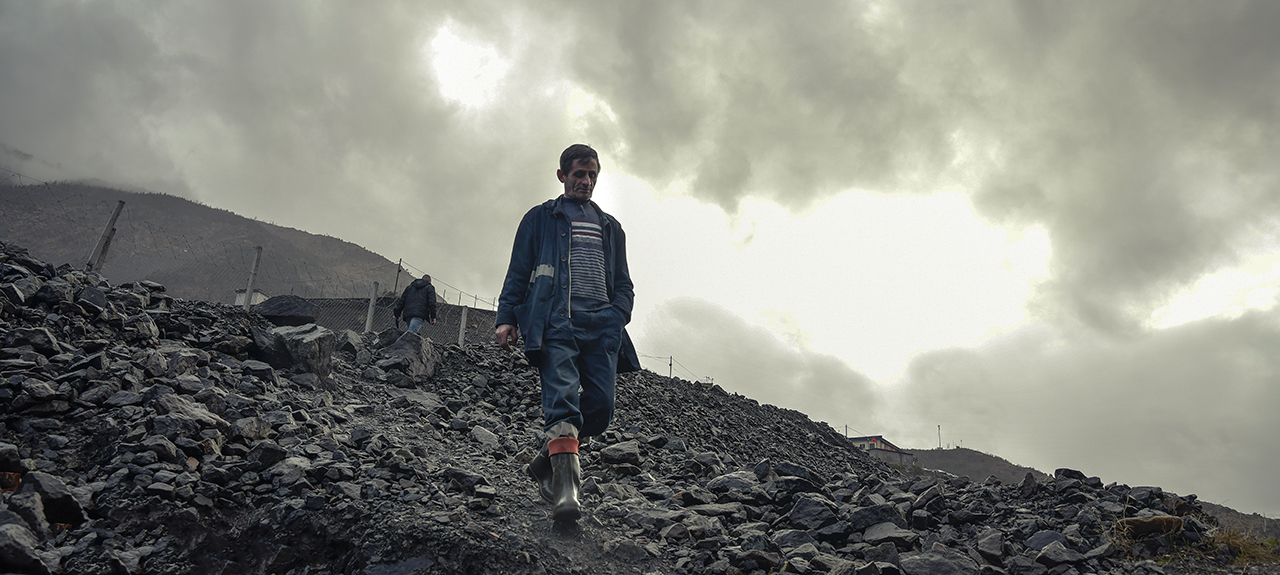
Over the years, Bulqiza’s miners have protested for better working conditions and higher wages. Photo: Atdhe Mulla / K2.0.
“Together with a group of trustworthy guys, we continuously worked to establish the [new] union,” Elton says.
On October 15, 2019, a court in Tirana recognized their union as legitimate. One month later, standing in the town center, they announced the establishment of the Syndicate of Unified Miners of Bulqiza. Elton was elected as the head of the union, while Beqir became head of finances.
After finding out that the new head of the union had been sacked, the miners decided to go on strike from November 25 in front of the company’s offices in Bulqiza.
But on November 19, Elton was called to AlbChrome’s Bulqiza offices, where he was told that the new union was not recognized by the company and asked what his objectives were.
He was also told that on November 21 he had to go to the company’s central office in Tirana for a meeting. In this meeting, he says he heard the same words, although this time his employers also raised some of his absences.
According to Elton, he was accused of being absent from work on five consecutive days one month earlier. He says that he had been absent because one of his children was ill, that he had a medical report to prove this, and that he had notified his supervisors in due time about his absence.
However, on November 23 he was dismissed from work under the justification that he had violated work ethics and had failed to respect the work schedule.
After finding out that the new head of the union had been sacked, the miners decided to go on strike from November 25 in front of the company’s offices in Bulqiza.
On that day, Beqir was called to the company’s offices in Tirana. According to him, the company also accused him of having been absent from work; he claims that he was only absent for a few minutes and that this happened as a result of long queues at the entrance of the mines.
Beqiri returned from Tirana and went straight to the strike, which the miners were intent on keeping up, despite ceaseless pressure from the company. However, after the earthquake that rocked Albania in late November, they paused the strike for a few days in a show of solidarity with the victims.
They continued the strike on December 1 for another three days. But on December 3, Beqir was notified that he had been dismissed from work.
“Afterwards, they started to blackmail the miners, telling them that if they didn’t return to work, they wouldn’t be paid at the end of December,” Beqiri says.
At the beginning of 2020, following another protest from the miners, they were notified by the company that they would in fact be compensated.
Beqir believes that the company dismissed him and Elton in order to make an example of them in front of the other miners — that if they continued to protest, they would also be dismissed. He says that this is what happened to Behar Gjimi and Ali Gjeta, who were also part of the new union’s Council and were also dismissed under the justification that they had unauthorized absences.
“I never received complaints from my supervisors about being late for work or leaving early,” Elton says. “Why did these complaints suddenly surface when we established the union and sought our rights?”K
AlbChrome was contacted for interview by K2.0 but did not respond to the request.
Feature image: Atdhe Mulla / K2.0.
Feature video: Trëndelinë Halili / K2.0.










